Date: 12 May 2018
After spending all of yesterday visiting Choeung Ek genocidal center, Tuol Sleng Genocide Museum and exploring other sights in Phnom Penh, we woke up really early to go for a sunrise cruise on the Mekong river. I booked the tour with Memorable Cambodia. It cost $20 per person for the 5:30am trip.
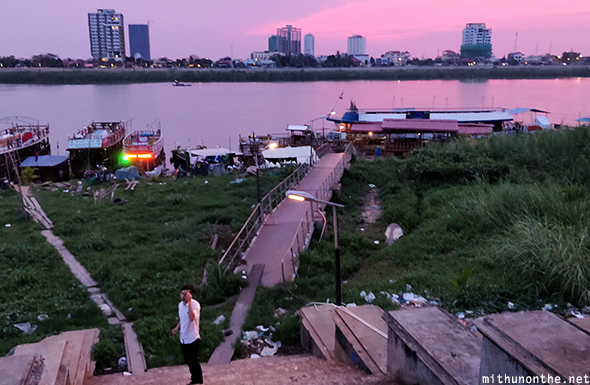
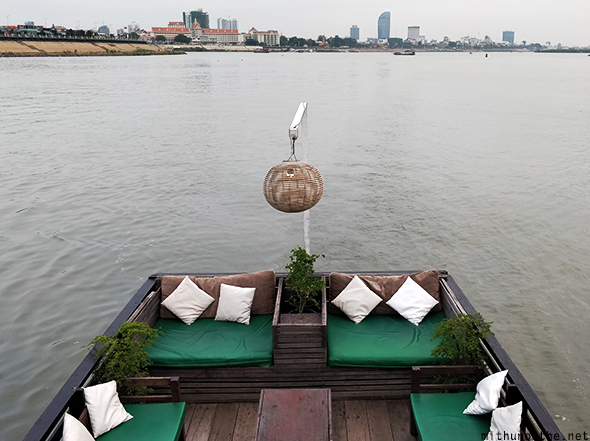
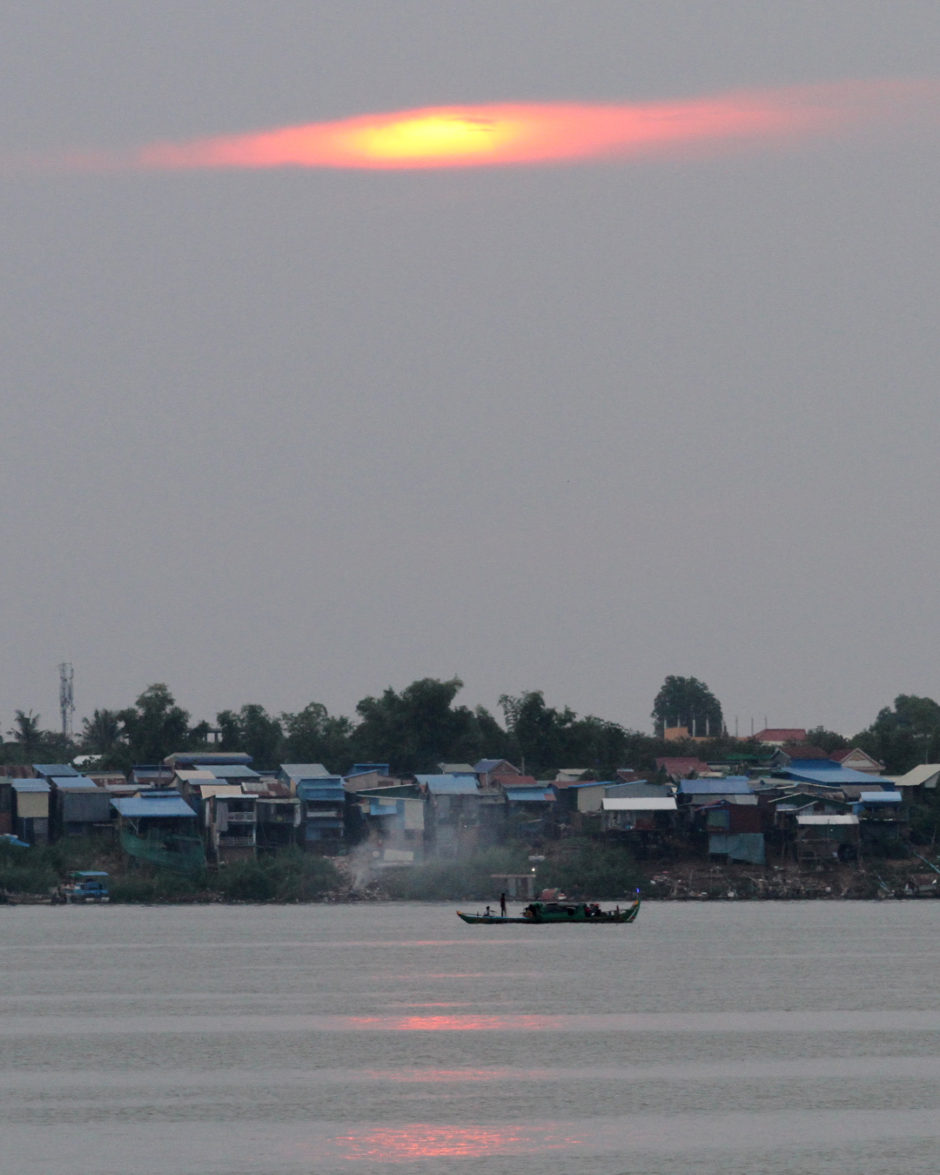
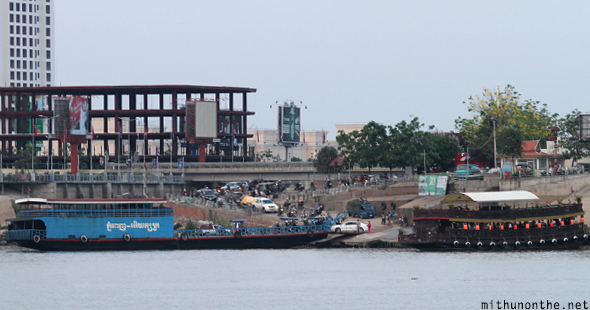
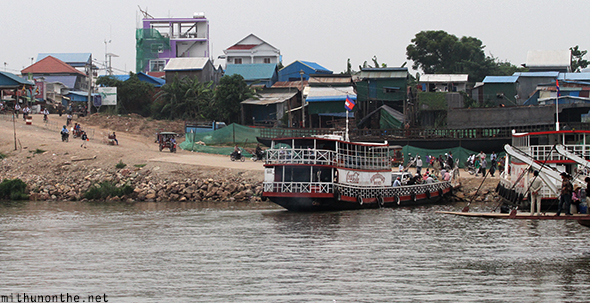
While we were served juices and freshly cut fruits, I could not help but notice the stark contrast between the two sides.

The minute I stepped out of Phnom Penh airport, I could not help but notice the amount construction going on in the city, much of it by Chinese companies. There are projects funded by Korean and Japanese companies too but the Chinese investment far outnumbered those.
I used the opportunity of having a local Phnom Penh resident (who could also speak English) with us to ask him about China’s growing presence in his country. I started by asking him about the high rise apartment buildings coming up in Phnom Penh.
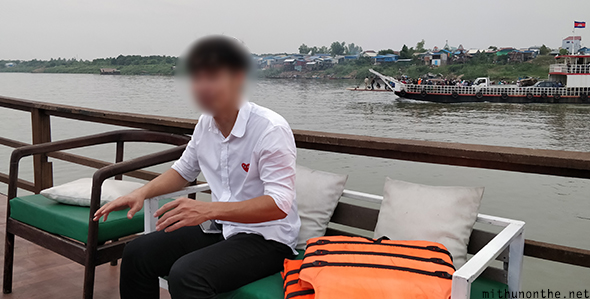
He told me most of these luxury apartments are built by Chinese companies for Chinese buyers. Only a few Cambodians can afford them so the majority are bought by Mainland Chinese as real estate investments and only a few migrating to Phnom Penh. He told me about how some Chinese are buying multiple apartments, sometimes an entire floor of apartments to spend their new found wealth (and in some cases, illicit wealth too). Reading about Chinese buying apartments in Phnom Penh — it’s certainly not cheap. According to this Reuters article from 2018, the average going rate is $350 (Rs. 24,000) per square feet. Very expensive considering the average Cambodian in Phnom Penh earns less than $1000 per month. But as stated, Cambodians are not the primary customer target for these builders.
Chinese buying property abroad is nothing new. They are now amongst the highest buyers of property in places like Vancouver, UK, Australia, Singapore and United States. Buying expensive property (or property that foreigners are eligible to buy) is usually a path to migration and many Chinese are taking advantage of it, especially the newly rich and upper middle class. Those who can’t afford the global cities of the “first” world are looking to countries like Cambodia, where property is still cheaper than the big Chinese cities like Shanghai, Beijing and Shenzhen.
Our host was a young college graduate who after completing his degree in tourism, he and his batchmates started a tourism company. He also had a lot to say about Cambodia’s “corrupt politicians” in power and how they are basically “selling Cambodia” to the Chinese. It may sound like an exaggeration coming from the youth complaining about politicians but when you hear about how in 2008, a Chinese company was granted a 99-year lease to around 20% of the kingdom’s total coastline at the modest price of US$30 per hectare, he’s not that wrong to think that way.
He even spoke about Sihanoukville, which I was curious about since I had thought about visiting the famous beach town during this trip. Except, he told me it’s no longer known for its beaches. Chinese investment has basically turned the coastal city into a casino town. I had to look it up and it’s true. There are going to be nearly 100 casinos in Sihanoukville and most if not all, built by Chinese for (mostly) Chinese tourists. This Channel News Asia snippet sums up well what’s going on there.
The above video clip is from a series by Singapore’s Channel News Asia which looks at China’s investments as part of their Belt & Road Initiative (BRI). You can find episodes on it focusing on Myanmar, Vietnam and Laos, Thailand and Cambodia. I’ve watched them all and the story is more or less the same. It’s just that among all those countries, Cambodia has cosied up the most to China. Much of the investment from China for BRI-related infrastructure comes in the form of loans which the host nations have to pay back. China funds projects, mostly Chinese companies are allowed to build those projects and in the end, the host nation that gets the infrastructure foots the bill and has to pay China back.
NOTE: Some will argue this how foreign loans all work... but that's not always the case. The truth is always in the fine print. France helped partially fund Kochi Metro in Kerala but AFD (France's Development Agency) is just one of many stakeholders of the project. Alstom, the French engineering giant provides the trains but those coaches are manufactured in India and the workers at Alstom's Chennai plant are mostly all Indian.
Raw deal for the recipient nation or not is debatable, but the problem comes when poorer nations fail to repay the debt owed to China. In 2011, China reportedly agreed to write off an unknown amount of debt owed by Tajikistan in exchange for some 1,158 square kilometers of disputed territory. Tajikistan only agreed to provide 5.5 percent of the land that Beijing originally sought. Worse still is when China takes over the entire project, like they did with Sri Lanka’s Hambantota port (now under China’s control for 99 years) and 15,000 acres of land around it for a SEZ (Special Economic Zone).
It’s not just in Cambodia where one can see visible Chinese investment while travelling this part of the world. I did the Golden Triangle tour from Chiang Mai (Thailand) twice — first in 2012 and again in 2018. One gets to visit Golden Triangle Special Economic Zone in Laos, a trade corridor built by China. In my last tour, I could see even more construction coming up all along the Mekong river.
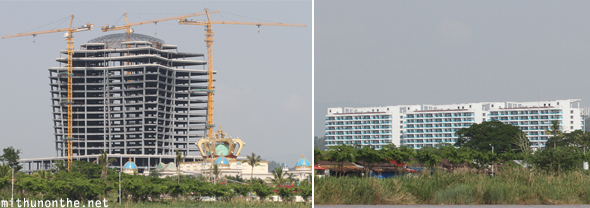
Not all projects in Cambodia are debt-based though. State-owned China Road and Bridge Corp. is building a $2 billion expressway from Phnom Penh to Sihanoukville and they hope to recover the cost by collecting tolls — for the 50 years CRBC will manage it. Not all construction projects across South East Asia are linked to the BRI either. Chinese companies are just investing outside China after making their initial riches during China’s boom period these past two decades.
Why is China spending all this money and spreading its influence? Well, for one, China has more money now than it ever did. Also, China is the ‘factory of the world’. After Mao closed off China in the 1960s and ruined much of its industrial economy, Deng Xiaoping, who took over leadership after Mao’s death, brought about massive economic reforms. China opened to foreign investment in the 1980s, built special economic zones (SEZ) one after another and used its massive population as low cost labour to lay the foundation of China’s manufacturing prowess. Allowing free-market enterprises, SEZs, and foreign investment created millions of jobs, lifting most of the country out poverty and the government made billions from taxes and trade revenues. It’s the story of many countries, India included, that brought about economic reforms after failed socialist/Communist economic models.
Problem is, as China grew richer and per capita income grew, labour costs went up too (as it generally does). China’s low-cost labour isn’t as low as it used to be and China knows it cannot lose out to other emerging economies like India and Vietnam when it comes to manufacturing. But if China needs to maintain its manufacturing advantage and trading partners, they need to secure cost-effective access to those markets. Not every country China trades with can easily be accessed by sea.
Some of the investment as part of the BRI projects across the region also include factories setup in SEZs by Chinese companies who wish to take advantage of the cheaper labour in countries like Laos, Cambodia and Vietnam. Companies may employ locals but much of the corporate taxes are still being paid back in China. China’s investment in certain countries are also to gain greater access to raw materials. Raw materials — including valuable ‘rare earth,’ a lot of which go into electronics — among other minerals, which continents like Africa have a lot of.
Which is why China has been investing heavily in Africa for over a decade. Government-owned China General Nuclear Power Corporation (CGNPC) acquired Husab project in Namibia which has one of the biggest uranium deposits in the world. That is just one of the many examples of mines being taken over by Chinese companies.
The accusations of Cambodia being “sold off” to China are also being made by some Africans with respect to their nations. This article highlights that accusation in the context of what’s going on in Zambia. The below debate from a Kenyan news channel talks about the issue of Chinese debt but the panelists don’t entirely blame China for the situation African nations are in… they blame their corrupt politicians more.
And they are absolutely right. The world isn’t like it was in the colonial era, when European colonists used their superior tools of warfare and colonized much of Africa, Asia and South America. They used the natives as slave labour and grew richer from exploiting the colonies’ resources, while the natives remained poor. Most countries in these aforementioned continents are all free nations now — much of them ruled by democratic governments. China didn’t roll into these countries with tanks and fighter jets and “exploit” their resources. China signed deals with the politicians of these participating countries. The contracts signed have terms and conditions, like any consumer bank loan has. Default on payments and there will be repercussions. Larger blame falls on the corrupt politicians of these loan taking nations for mismanagement of funds. If the nation’s economists tell you that the nation’s finances cannot afford to pay back on the terms China places, simply don’t take the money. Sierra Leone and Malaysia said ‘no’ and have cancelled some projects backed by China’s loans claiming the projects were financially unviable or could be done for less themselves.
Post the Korean war, South Korea too once took foreign loans to rebuild the nation and went through decades of political turmoil and corruption, but ultimately they sorted themselves out and are now one of the richest countries in the world with rising soft power influence (thanks to K-pop, Korean dramas and their companies) and have a very affluent population. If after decades of Western colonization, African and Asian countries are now complaining about “Chinese imperialism” or the colonial past for their continued woes… well, they may want to question their own politicians post-independence a lot more. You cannot keep blaming foreign powers forever (India is no exception either).
Of course, let us not ignore the fact China also knows the kind of politicians they are dealing with. China knows many of these leaders are corrupt, they just used it to their advantage… and it’s working. When China takes over projects in a loan-recipient nation and grows its influence in these countries, it can also arm-twist those governments (at least the poorer ones) to sway in China’s favour when the need arises. Cambodia does that now for China at the ASEAN over the South China Sea dispute.
China does deals with Singapore and now many Western European nations as part of BRI too, but you don’t hear about similar allegations of China messing with countries like Singapore and Italy, simply because: a) those countries got wealthy even before China did; b) their governments negotiate better terms. It’s the poorer nations where corruption is rife that are facing allegation of “Chinese debt trap”.
Pakistan now owes the most to China in terms of loans, to the tune of some $60+ billion. Pakistan’s current prime minister, Imran Khan, is now having to borrow money from Saudi Arabia and elsewhere to help Pakistan balance its books. How that’s going to work out for Pakistan remains to be seen. India is not part of the BRI, but in my opinion it can be — but only if we make the argument Malaysia’s Mahatir made after he came to power and demanded renegotiating the terms China made with his predecessor Najib Razak (who was jailed over massive corruption charges — watch this for a summary on the 1MDB scam). Mahatir wants Malaysian companies and Malaysian labour to be more greatly involved in any project funded by China on Malaysian soil. If India were to get involved in the BRI, Indian companies must be the ones handling all construction on India’s side — and the Indian government owns our side of the infrastructure. China can own everything on its side. I feel India can get involved in the BRI from the North East side of our country, which will help boost the economies of India’s North Eastern states and the lesser developed Western China side — while also facilitating easy trade access with Bhutan and Nepal along the way. It is possible to construct something that benefits everyone without getting sunk into the “China debt trap” argument.
Whatever the West is accusing China of now over “debt traps” were the same accusations leveled against the IMF and World Bank decades ago. The United States has the money to counter China but they choose not to because historically the US government only acts as the negotiator on behalf of its corporations who carry out the work (and the US just collects the taxes from them) whereas China strikes deals on behalf of its many state-owned corporations and companies close to Beijing. It’s they who are carrying out much of the projects as part of the BRI, who then rake in the profits and a share goes back to the Chinese government (which is basically China’s Communist Party as there is no other political party allowed).
When America is dropping bombs the world over (along with Russia in Syria), China is seen building infrastructure across Asia, Middle East and Africa. Sure, the threats of debt-traps loom, but ask the average layman of the recipient nation about China — what would they rather have — bombs or new infrastructure? Obviously the latter. At the end of the day, China is seen as the country building bridges and America is seen as the country destroying them.
If USA wishes to counter China, they can start by out-spending Germany, France and Japan in lending low interest loans for big infrastructure projects. On one hand USA is one of the largest donors of foreign aid in cash and food (great) — but then does billions in business from selling weapons to governments (like Saudi Arabia) that cause conflicts and destruction (and now warmongering with Iran). China and its supporters of the BRI can always use this excuse against USA… and they do.
You would think a nation like Cambodia, with its rich Hindu heritage, India would be a key player here. But apart from India offering legitimacy to the post-Khmer Rouge leadership and Archaeological Survey of India aiding in the restoration of the Angkor Wat temple starting 1986, India has played a very small role in assisting Cambodia financially. The only visible sign of India’s growing presence in Cambodia now are Bajaj autos everywhere on the streets of Phnom Penh.
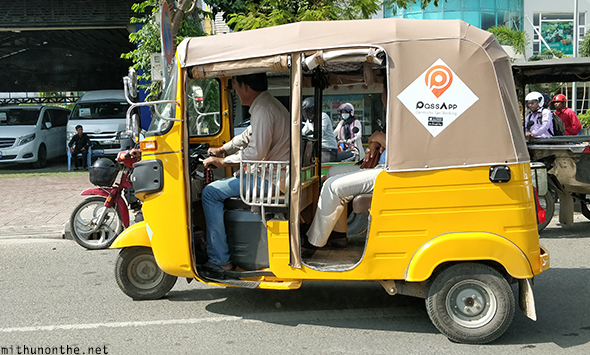
If you are wondering how come China has gotten a lot more from Cambodia than other nations in the region, for that you need to understand Cambodia’s political landscape first (or you can read this more detailed article). After the Khmer Rouge regime fell, the Cambodia People’s Party (CPP) came to power. Hun Sen (who was himself formerly with the Khmer Rouge) took office as the Prime Minister in 1985… and has been in power ever since. Yes, Cambodia is a “democracy” but one in which on Hun Sen’s orders, the CPP voted unanimously to abolish the Minority Leader and Majority Leader positions to lessen the opposition party’s influence in 2017. And in the same year, Hun Sen barred the opposition from questioning some of his government ministers and then later passed a controversial law effectively granting the ruling party the right to dissolve political parties. Which they did with the main opposition party, the Cambodia National Rescue Party, and now their leaders are barred from contesting election for five years. Then the usual tactic of threatening voters which also helps.
All this gives Hun Sen the staying power he needs. His grip on Cambodia doesn’t end there. Hun Sen is already prepping his eldest son, who is a general in the Cambodian army, to be his successor. Needless to say, Hun Sen’s family had benefited greatly by having papa rule for a long time. Three of Hun Sen’s children are listed as owners of Cambodia Electricity Pvt. Ltd. one of the largest electricity providers in the country. Hun Sen’s eldest daughter owns a pro-government newspaper and three broadcasting stations. There’s a lot more on Hun Sen’s extended family in this report and article.
Is China aware of all this? Of course they are. But since Hun Sen can rely on China instead of the West who constantly accuse him of “human rights violations,” Hun Sen will give what China wants and China will continue to work with Hun Sen to their benefit. At the end of the day, it’s just ‘business’. China is doing the same with Duterte in the Philippines. This documentary from ABC (Australia) is a good watch on Hun Sen… and at 25:09 it shows you what happens to anyone who dares to expose Hun Sen’s corruption.
And it’s not just Hun Sen. Among all the gifts (not loans) China has given the CPP and its leaders is the below building — where the government officials all sit.
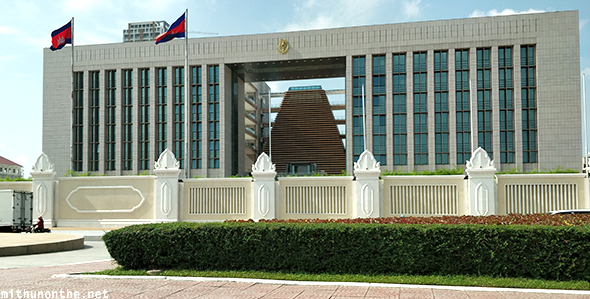
It doesn’t stop there. If Cambodia’s ministers ask for printers and office equipment, China will deliver them too. Don’t the Cambodian know all this just basically amounts to bribery of some form? Of course they do. Our host mentioned how CPP leaders are all getting rich from dealing with Chinese businessmen… but before anyone complains, how is this different from any other country suffering from corruption? Well, one difference is, unlike India where you have active opposition politics, with the way Hun Sen rules Cambodia, the Cambodian people have little voice against him or CPP’s decisions.
Also, Cambodia was for the longest time a lot more poorer than it is today. Now, there are development projects all across Cambodia. Jobs are being created and regardless who ends up buying the luxury apartments, Cambodians are finding employment from tourism, construction and other services… which is still better than not being employed at all and no development. Cambodians are at a stage where they are choosing between a rock and hard place — the rock being their past and the hard place that is now a Cambodia with a huge Chinese influx.
Of course, this sort of development under corrupt governments also means there are many losers — all of whom are poor indigenous Cambodians. Protests against land acquisition by Chinese companies are now commonplace in Cambodia.
The other problem for the Cambodian people now seems to be the ever growing presence of “unwanted Chinese”. Our host told us that Cambodians don’t even visit Sihanoukville for weekend breaks like they used to as the place has been “taken over by Chinese gangs”. Again, “taken over” maybe an exaggeration but the gangs do exist in Sihanoukville.
Reading Cambodian online news since my trip, there is no shortage of arrests being made of Chinese nationals in Cambodia for everything from running call center scams, trafficking of drugs and money to kidnapping and torture. Chinese gangs based in Cambodia getting arrested in cases relating to scamming Chinese in the mainland and gambling-related debt are now quite common. If more such crimes by Chinese nationals in Cambodia grow, the perception of the Chinese will only deteriorate over time. That said, Cambodians also hate the Vietnamese — that’s what our host told us — which I found ironic since it was Soviet Union-backed Vietnam that helped liberate Cambodia from the Khmer Rouge (but many Cambodians also term that “liberation” as an invasion).
Oh well… back to the tour.
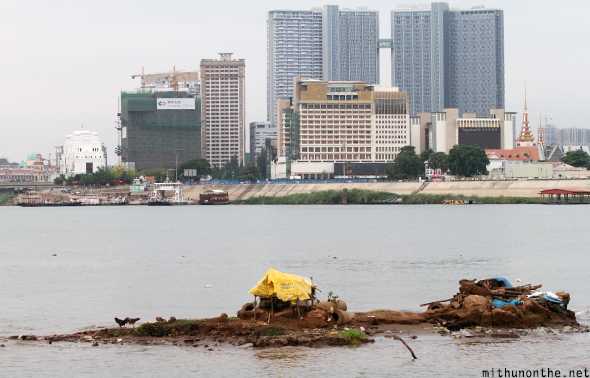
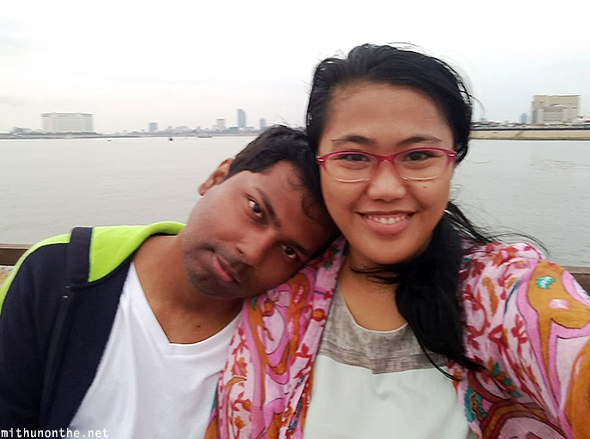
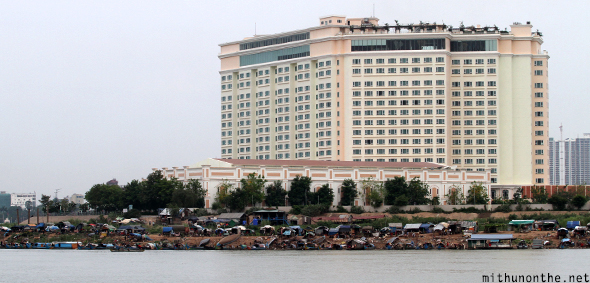
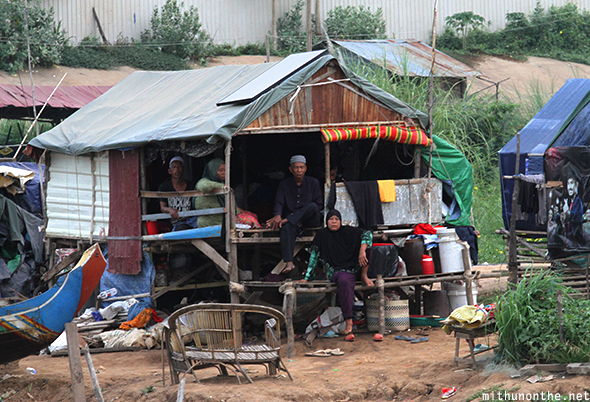
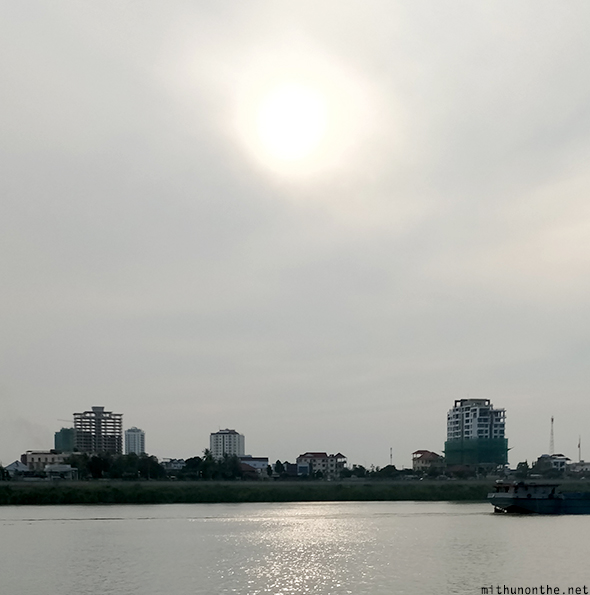
Is the sunrise cruise worth it? It’s up to you. Maybe the weather wasn’t great today so the sunrise was nothing to go “wow” over. It was a pleasant hour-long ride, that’s all.
Next up, we visit the Royal Palace before packing our bags, saying goodbye to Phnom Penh and leaving for Siem Reap.
Next post(s) in this series:
Cambodia: Royal Palace and Silver Pagoda in Phnom Penh
Cambodia: Phnom Penh to Siem Reap by bus
Cambodia: Bayon temple – the one famous for stone faces
Previous posts in this series:
Cambodia: Phnom Penh Central Market and Wat Phnom
Cambodia: S21, the Tuol Sleng Genocide Museum
Cambodia: Choeung Ek genocidal center — the infamous “Killing Fields”
Cambodia: Sisowath Quay, Phnom Penh Night market
Cambodia: Arriving in Phnom Penh

